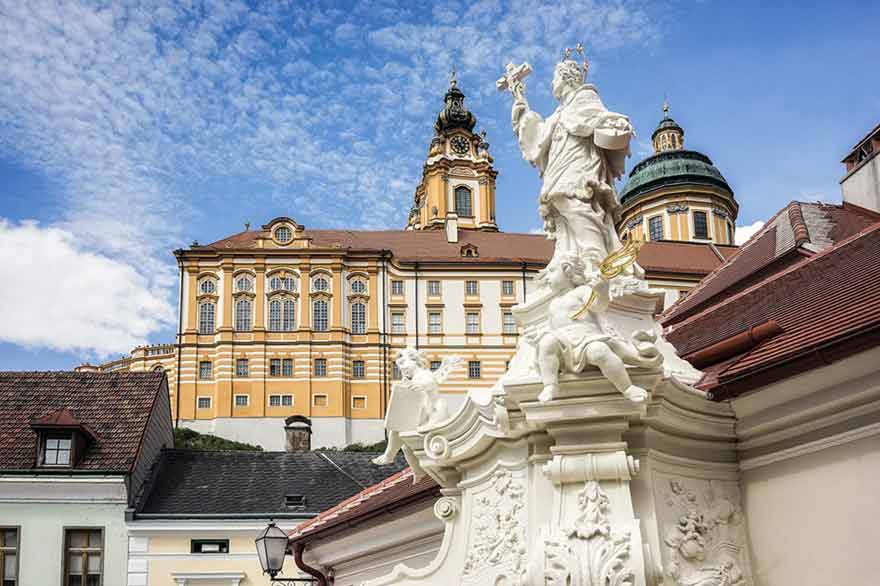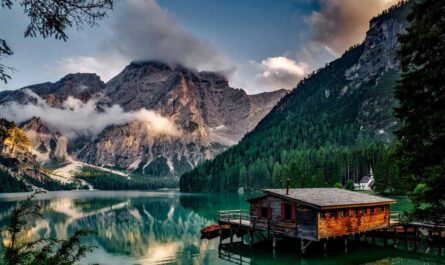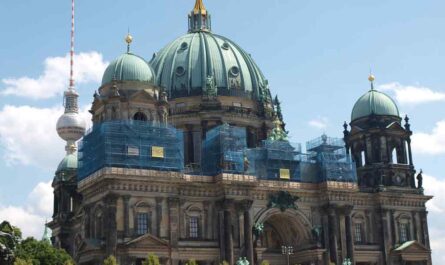There are many interesting facts about Austria. This European country is stuffed with a lot of achievements, ancient history, growth of civilization, bravery, and thrive. Austria boasts breathtaking natural beauty, with the Alps dominating the western and southern regions. The country is dotted with lakes, including the picturesque Lake Wolfgang and Lake Neusiedl. The Danube River gracefully flows through the eastern plains, offering scenic views. In this article, I am going to talk about some interesting facts about Austria.
Interesting Facts about Austria: Past and Present
The majority of Austrians speak German, reflecting the country’s cultural and historical ties with the German-speaking world. Austrians are known for their warm hospitality and a strong sense of community. Religion plays a significant role in Austrian life, with the majority of the population adhering to Roman Catholicism. This religious heritage is evident in the country’s historic churches and religious festivals that dot the calendar. The people are known for their industrious nature and commitment to quality craftsmanship. Here are some interesting facts about Austria:
1. Renewable Energy Dominance
Nestled in the heart of Europe, Austria boasts an impressive feat on the global stage of sustainable energy practices. Surpassing the majority of nations, this Alpine haven generates a staggering 60% of its electrical energy from renewable sources. A testament to its unwavering commitment to environmental stewardship, Austria stands as a shining example of how a nation, despite its geographical constraints, can harness the power of nature to illuminate its cities and homes. The majestic landscapes of the Austrian Alps not only captivate the eye but also play a pivotal role in shaping a future where green energy reigns supreme.
2. Border Tapestry
Austria, though modest in geographical expanse, unfolds like a multi-faceted gem with borders interwoven with eight distinct nations. The tapestry of its boundaries includes the Czech Republic, Germany, Hungary, Italy, Liechtenstein, Slovakia, Slovenia, and Switzerland. This intricate dance of neighboring countries renders Austria a crossroads of cultures, where historical legacies and contemporary influences converge. Amidst the peaks and valleys, Austria’s identity is etched not only in its landscapes but also in the shared narratives of the nations that embrace its borders.
3. Austria’s Economic Prosperity
Nestled in the heart of Europe, Austria stands out as one of the most prosperous nations globally, boasting an impressive economic status, a testament to its thriving Gross Domestic Product (GDP). This economic prowess positions Austria among the wealthiest countries on the planet. The nation’s financial strength is a result of its diverse and well-developed industries, encompassing technology, tourism, and manufacturing.
4. Generous Leave Policies
Austria not only excels in economic prosperity but also champions the well-being of its citizens through progressive labor policies. Every Austrian worker is entitled to a minimum of 22 paid vacation days and 13 paid holidays annually. This commitment to ensuring a healthy work-life balance underscores Austria’s dedication to the overall welfare and satisfaction of its workforce. Such extensive leave allowances contribute to a robust societal emphasis on leisure and personal time.
5. The Ill-Fated Overseas Arrival
In the annals of the king’s menagerie, the overseas animals held a special place, marking the inception of a fascinating chapter. Among these exotic creatures, one that etched its presence into the Austria animals’ historical tapestry met a poignant fate. Regrettably, the austere embrace of Austria’s chilly local weather proved insurmountable for this foreign guest, leading to its untimely demise in the frosty December of 1553. Yet, amid the somber echoes of its short-lived existence, a curious artifact endures—a chair crafted from the very bones of this erstwhile visitor, now enshrined at the Kremsmünster Monastery. This chair serves as a silent testimony to a bygone era when distant fauna ventured into the heart of Austria, leaving behind whispers of an enigmatic encounter.
6. The Origin of Vienna’s Prater Park
The verdant expanse of Vienna’s Prater Park unfolds a narrative that reaches back to the annals of 1194. The roots of its nomenclature delve into the generosity of Babenberg Duke Friedrich I, who bequeathed a portion of Vienna’s woodlands alongside the sinuous Danube River as a gift. This wooded haven, originally bestowed upon an Italian royal lineage named de Prato, witnessed a metamorphic transformation, with the recipients altering their moniker to Prater. The evolution of this park’s name intertwines with the tendrils of history, weaving a tale that resonates with the ebb and flow of time, where royal gifts and identity transformations meld into the scenic fabric of Vienna.
7. The Workweek Tapestry of Austria
Within the temporal fabric of European workweeks, Austria emerges as a noteworthy protagonist, contributing a unique thread of industrious dedication. The average workweek of an Austrian, spanning an impressive 45 hours, unfurls a narrative of laborious commitment that surpasses the temporal investments of their European counterparts. This statistic not only quantifies the dedication woven into the Austrian work ethic but also underscores their enduring commitment to professional pursuits, painting a canvas where time becomes the brush, sketching the contours of diligence and industry.
8. Bertha von Suttner’s Noble Triumph
In the chronicles of Nobel laureates, a distinct name graces the pages, breaking the gendered barriers that once constrained such accolades. Austrian-born Bertha von Suttner scripted history in 1905 by becoming the inaugural woman to be bestowed with the prestigious Nobel Peace Prize. Her indomitable spirit and advocacy for peace resonate through the ages, transcending societal norms and cementing her legacy as a trailblazer. Bertha’s journey to this pinnacle of recognition illuminates the path for future generations, adding a luminous chapter to the ongoing saga of women’s accomplishments on the global stage.
9. Cultural Pride in Mozart
Austria’s cultural tapestry is interwoven with the legacy of Wolfgang Amadeus Mozart, and its citizens take immense pride in being the birthplace of this musical genius. One distinctive manifestation of this cultural celebration is the creation of the “Mozartkugel.” This delectable treat is not just any chocolate; it is a symbol of Austria’s homage to Mozart, crafted with precision and regarded as a culinary masterpiece. The Mozartkugel encapsulates the nation’s deep-rooted connection to its artistic heritage.
10. The Ibex Conservation Triumph
Austria’s natural landscape is home to the majestic ibex, a species of mountain goat that faced the brink of extinction. However, a remarkable conservation effort has unfolded over the past two decades, rescuing and restoring the ibex population. This success story stands as a testament to Austria’s commitment to preserving its biodiversity. The once-endangered ibex now roams the Austrian mountains, embodying the nation’s dedication to environmental stewardship and the delicate balance between progress and nature.
11. Harmonic Extravaganza: Salzburger Festspiele
In the realm of cultural grandeur, Austria claims its throne with the annual Salzburger Festspiele, an opulent celebration that transcends the boundaries of conventional opera and theater festivals. This grandiose spectacle stands as the unrivaled pinnacle of artistic expression in Europe, a stage where the finest performers converge to weave a tapestry of sonic and visual marvels. The legacy of the Salzburger Festspiele reverberates through the ages, etching Austria’s name in the annals of cultural brilliance, where each note played and every act performed contributes to the symphony of human creativity.
12. Timeless Melodies: The Vienna Boys Choir
In the heart of Vienna, a living testament to centuries of musical excellence resonates—the Vienna Boys Choir. Established in the hallowed year of 1498, this illustrious ensemble stands as a paragon of vocal virtuosity. With a legacy as enduring as the melodies they weave, the Vienna Boys Choir transcends time, enchanting audiences with harmonies that echo through the corridors of history. Each performance becomes a pilgrimage into the world of classical music, where the voices of past and present unite in a celestial choir, leaving an indelible mark on the global cultural tapestry.
13. Austria’s Environmental Virtue: Recycling as a National Ethos
Beyond the realms of cultural idiosyncrasies and historical achievements, Austria proudly wears the mantle of environmental stewardship. A nation seemingly sculpted by the picturesque landscapes of the Alps, Austrians exhibit an unwavering commitment to sustainability. At the forefront of this conscientious movement, Austria boasts an impressive statistic—63% of its waste undergoes the intricate dance of recycling, marking the pinnacle in waste management percentages across Europe. This commitment to environmental responsibility not only reflects a national ethos but also stands as a testament to the symbiotic relationship between the Austrian people and the pristine beauty that envelops their homeland.
14. Austria’s Pioneering Stance on Natural Farming
Austria stands as a trailblazer in embracing a holistic approach to agriculture by becoming the first nation to codify comprehensive nationwide laws centered around natural farming. This forward-thinking initiative underscores their commitment to sustainable agricultural practices, advocating a conscientious departure from conventional methods. The Austrian regulatory framework vehemently rejects the incorporation of biotechnology as a panacea for bolstering crop yields. This resolute stance showcases Austria’s dedication to preserving the integrity of its agricultural landscape, championing environmentally friendly practices over potentially invasive technological interventions.
15. The Ingenious Legacy of Josef Madersperger
An intriguing facet of Austria’s inventive history unveils itself through the ingenious mind of Josef Madersperger, credited with the invention of the stitching machine. This revolutionary device, born from Austrian ingenuity, forever transformed the landscape of textile manufacturing globally. Madersperger’s pioneering contribution resonates as a testament to Austria’s legacy of innovation, leaving an indelible mark on industries far beyond its borders. This fun fact about Austria not only highlights its technological prowess but also serves as a testament to the nation’s enduring impact on the evolution of everyday conveniences.
16. Mandatory Army Training in Austria
In the picturesque landscape of Austria, a distinctive aspect of the societal fabric unfolds in the form of obligatory army training for all Austrian males. This immersive experience, lasting less than a year, is an integral part of the national ethos. However, the commitment to military preparedness doesn’t conclude with the initial training stint. Rather, there exists an ongoing requirement for periodic retraining, underscoring the nation’s dedication to maintaining a vigilant and prepared citizenry. This multifaceted approach to military service not only shapes individuals but also contributes to a broader sense of national unity and resilience.
17. Social Partnership: The Austrian Way of Compromise
At the heart of Austrian societal dynamics lies a distinctive principle – compromise. This ethos finds a tangible expression in the concept of Social Partnership, a remarkably successful practice that serves as a harmonizing force in the relations between employers and employees. In essence, Social Partnership is a cooperative alliance wherein trade unions and business leaders collaborate to formulate policies and practices that mutually benefit both parties. This unique approach fosters a work environment where divergent interests find common ground, promoting stability and inclusivity in the Austrian workplace.

18. Sporting Passions in Austria
Among the diverse range of recreational pursuits embraced by Austrians, a fervent enthusiasm is reserved for sporting activities that mirror the country’s rich topography. A perennial favorite is skiing, where the majestic Alps provide an exhilarating backdrop for enthusiasts gliding down powdery slopes. Football, a universal passion, finds a dedicated following in Austria, fostering a sense of communal spirit as teams compete for glory. Mountain climbing, with its inherent challenges and breathtaking vistas, captivates those seeking an adrenaline rush amidst the rugged landscapes. Water-skiing, an aquatic endeavor, adds a splash of excitement as enthusiasts navigate pristine lakes. The allure of cruising, whether on rivers or serene lakes, also beckons Austrians to embark on leisurely voyages, basking in the tranquility of nature’s wonders.
19. Pioneering Postcards from Austria
Austria, a nation steeped in historical significance, boasts a unique claim to fame—the birthplace of postcards. It was on Austrian soil that these small, picturesque cards first made their appearance, ushering in a revolution in communication. This intriguing nugget of history not only underscores Austria’s cultural contributions but also illuminates the pivotal role it played in shaping the way people connect across distances. Postcards, with their compact canvas of art and imagery, became a tangible testament to shared experiences, encapsulating the beauty of Austria’s landscapes and the richness of its cultural tapestry.
20. Literary Legacy at the Austrian National Library
Nestled in the heart of Vienna, the Austrian National Library stands as a venerable repository of knowledge, embodying centuries of intellectual endeavors. As one of the world’s preeminent libraries, its significance transcends geographical boundaries. The library’s hallowed halls safeguard a trove of literary treasures dating back to the 14th century, providing an immersive journey through the epochs of human thought. With over 2 million books nestled within its shelves, the Austrian National Library is not merely an edifice of architectural grandeur but a living testament to the enduring pursuit of knowledge that defines the Austrian cultural ethos.
21. Egon Schiele: Artistic Provocation in Austria
Austrian artist Egon Schiele, a figure synonymous with controversy, left an indelible mark on the annals of art. In the tumultuous year of 1912, Schiele found himself entangled in a legal maelstrom, spending three weeks in custody. His transgression? The creation of provocative and erotic artworks that ran afoul of societal norms. Convicted of corrupting minors through his evocative paintings and drawings, Schiele’s artistic expression became a lightning rod for societal critique. Despite the turbulence of his narrative, Schiele’s legacy endures as a testament to the power of art to challenge conventions and provoke discourse, leaving an enduring imprint on the Austrian cultural landscape.
22. Krimml Waterfalls: Austria’s Natural Marvel
Amidst the captivating natural wonders that Austria boasts, the Krimml Waterfalls stand as an awe-inspiring testament to the country’s scenic grandeur. Soaring to an astonishing height of 1,247 feet, these cascading falls claim the title of the highest in Austria. The vertical descent of the water creates a mesmerizing spectacle that captivates the imagination of all who behold it. This natural marvel not only showcases the beauty of Austria’s landscapes but also beckons visitors to explore the diverse and breathtaking facets of the country’s geography.
23. Heuriger: A Charming Tradition of Austrian Socializing
Nestled within the cultural tapestry of Austria is the charming tradition of Heuriger, a unique form of wine tavern that transcends mere libations. Serving as a popular gathering spot for Austrians, Heuriger provides a convivial atmosphere where families and friends come together to enjoy delightful evenings. The spectrum of conversations that unfold in these cozy establishments ranges from lighthearted and casual to more profound and serious discussions. It’s not uncommon for these gatherings to extend well into the night, with buffets offering an array of both hot and cold culinary delights, complemented by the latest wines, contributing to an ambiance of shared warmth and camaraderie.
24. Christian Doppler and the Doppler Effect
Born in the picturesque city of Salzburg, Christian Doppler, a distinguished physicist, etched his name in the annals of science with his groundbreaking discovery of the “Doppler effect.” This phenomenon unravels the intricate relationship between the perceived frequency of sound and light waves and the relative motion of the source and detector. The Doppler effect, a cornerstone in the realm of physics, has found ubiquitous application in the Doppler radar, a technological marvel embraced by meteorologists worldwide. Its proficiency in discerning the subtle nuances of wave frequencies during motion has revolutionized weather forecasting, standing as a testament to Doppler’s enduring legacy in the scientific community.
25. Austrian Work Ethic and Weekly Commitment
Nestled in the heart of Europe, Austria boasts a work ethic that sets its denizens apart from their European counterparts. Austrians, on average, dedicate a formidable 45 hours per week to their professional pursuits, eclipsing the laborious commitments of other European nations. This industrious spirit permeates the fabric of Austrian society, reflecting a collective dedication to excellence and productivity. This unique work ethos is not merely a statistical outlier but an integral facet of the Austrian cultural tapestry, contributing to the nation’s economic resilience and global competitiveness.
26. The Importance of Eye Contact in Austrian Toasts
When engaging in a convivial toast with an Austrian, the cultural nuances surrounding eye contact take center stage. It is not merely a customary gesture; it holds significant weight in the realm of Austrian social etiquette. The failure to establish and maintain eye contact during such occasions is not dismissed as a mere social faux pas; rather, it is believed to attract a streak of misfortune. According to local superstition, the consequence for this breach of eye-related decorum is nothing short of seven years of ill-fated intimate relations. This intriguing blend of social custom and superstition adds a layer of complexity to the seemingly simple act of raising a glass in Austria.
27. Vienna’s Central Cemetery: A Resting Place for Legends
Beneath the historic cityscape of Vienna lies a burial ground that transcends the conventional notions of cemeteries. The Central Cemetery, a sprawling necropolis, cradles the remains of an astonishing three million individuals, a number surpassing the contemporary living populace of the city it serves. However, this is no ordinary burial site; it is a revered resting place for some of the greatest musical virtuosos the world has known. Among the illustrious residents of this necropolis are luminaries such as Beethoven, Brahms, Strauss, and Schubert. Their final resting places contribute to the cemetery’s unique blend of historical reverence and artistic legacy, making it an unparalleled testament to Vienna’s cultural richness.
28. Austria’s Landlocked Trio: Alpine Countries Unite
In the mosaic of European geography, Austria stands shoulder to shoulder with Switzerland and Luxembourg, bound by a common geographical trait—they are all landlocked nations. Nestled within the heart of the continent, these alpine countries share the absence of a coastline, a characteristic that shapes their national identities. The juxtaposition of mountainous terrains and the absence of coastal borders mark them as distinct entities in the European tapestry. This geographical kinship adds an intriguing dimension to Austria’s identity, connecting it with its landlocked companions in a harmonious dance of shared landscapes and cultural nuances.
29. Braunau am Inn: The Birthplace of Infamy
Embedded in the annals of history, the quaint town of Braunau am Inn, Austria, bears the ominous distinction of being the birthplace of one of the most infamous figures in modern history—Adolf Hitler. In the year 1889, this picturesque Austrian town witnessed the arrival of a man who would go on to shape the course of world events. Hitler’s early years unfolded against the backdrop of Braunau am Inn before he embarked on a fateful journey to Germany in 1913. This historical fact adds a chilling layer to Austria’s narrative, serving as a reminder of the complex historical tapestry woven within its borders. How AI, ChatGPT maximizes earnings of many people in minutes
30. Austria’s Pioneering Stance on Natural Farming
Austria, a trailblazer in environmental stewardship, earned the distinction of being the first nation globally to enact comprehensive national laws governing natural farming practices. This progressive stance underscores Austria’s commitment to sustainable agriculture and environmental harmony. The nation’s proactive measures in regulating and promoting organic farming serve as a beacon for others, aligning with the growing global imperative to foster ecologically responsible practices in food production. Austria’s pioneering role in championing natural farming exemplifies a harmonious coexistence between technological progress and environmental preservation.
31. The Timeless Austrian Flag: Symbolic Elegance
Austria’s national flag, with a history dating back centuries, stands as one of the oldest flags globally, radiating symbolic elegance and historical significance. Unveiling a distinctive design, the flag unfurls in three horizontal stripes – a mesmerizing alternation of red, white, and red. When hoisted by citizens, this triband composition captures the essence of Austrian identity. Intriguingly, when wielded by the government, the flag transforms, adorned with an additional emblematic layer. Nestled within the triband, an imposing eagle and a regal coat of arms take center stage, encapsulating the nation’s rich heritage and the enduring legacy of its sovereign symbolism.
32. Red Bull’s Soaring Origins in Austrian Terrain
Austria boasts another feather in its cap with the global phenomenon that is the energy drink “Red Bull.” Originating from Austrian ingenuity, this caffeinated elixir has transcended borders to become the preeminent energy beverage worldwide. Its creation signifies Austria’s role as a cradle for innovation, where the convergence of taste, branding, and functionality has birthed a cultural icon. As the highest-selling power drink on the planet, Red Bull’s meteoric rise stands as a testament to Austria’s ability to not only cultivate ideas but also successfully export them to a global audience, leaving an indelible mark on the beverage industry.
33. Werfen’s Subterranean Marvel: The Largest Ice Cave on Earth
For enthusiasts of subterranean wonders, the quaint town of Werfen in Austria holds a mesmerizing secret — the world’s largest ice cave. Spanning an astonishing distance of over 26 miles, this subglacial marvel captivates with its ethereal beauty and geological significance. Nestled within the heart of Austria, this expansive ice cave in Werfen serves as a testament to the country’s diverse natural wonders. A visit to this colossal frozen labyrinth offers a glimpse into the mystique of Austria’s geological heritage, providing an immersive experience for those intrigued by the subterranean splendors concealed beneath the surface.
More Interesting Articles
- 30 Interesting Facts about Abu Dhabi Tourism
- 20 Interesting Switzerland Facts One Should Know
- 26 Interesting Great Pyramid of Giza Facts
- 12 Persian Empire Facts and Achievements
- El Salvador History – How the Country Moves On
- History of Latin America – Twists and Thrills
- Spanish Colonization of the Americas
- The United States in Order of Statehood
- Dumb Laws in the US You Should Know before Travel
- British National Museum Tourists Guide with Time Table
- British History Museum Collection Tourist Guide
- 81 Interesting Facts about Singapore
- British War Museum Stands with a Glorious Past
- 130 Facts of El Salvador Everyone Should Know
- 52 Interesting Fun Facts about New Mexico, USA
- 200 Interesting Facts About Thailand
- Jollof Rice Recipe for Nigerian – Taste, and Preparation



